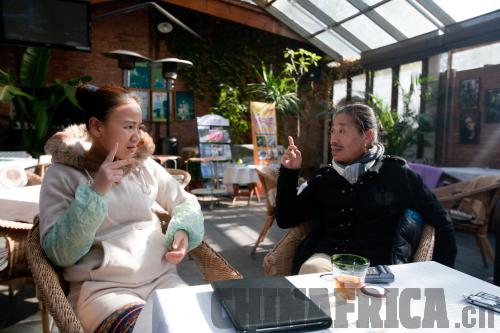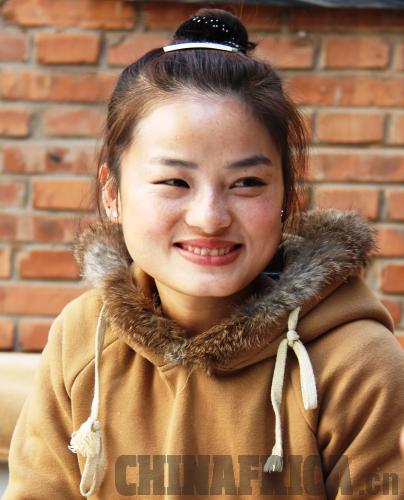|
 |
|
Restaurant owner Su Qing communicates with Chen Fangfang, the restaurant's head waitress in sign language (WANG XIANG) |
Confident smiles
Four years have passed. Many customers said they found confidence in the eyes of the those hearing-impaired restaurant servers, and saw happiness in their smiles. They greet customers with their unique brand of hospitality, and language does not stand in the way between customers and themselves.
Chen Fangfang, the restaurant's head waitress, is a pretty and intelligent deaf-mute girl. She once performed the dance "Thousand-arm Guanyin," (Goddess of Mercy) in the Art Troupe of Jiangxi Province, and she is also the heroine in Sign Language Age, a documentary filmed by Su Qing.
Chen explained in sign language that, of the 11 deaf-mute waiters and waitresses at the restaurant, half can communicate with customers, some can understand simple lip language, some communicate by writing down words, while some illiterates started reading from learning the dish names on the menu.
"Many customers are interested in learning some simple sign language, such as 'thank you', or 'I am sorry.' 'Thank you' is the most frequently used one. When they express 'thanks' in sign language, I can feel their respect for us," Chen told ChinAfrica.
Ye Xiaoling, a 22-year-old deaf-mute waitress, comes from Yongxiu County of Jiangxi Province. She didn't go to school until she was 14 years old, and only had four years of schooling. In 2009, she came to the restaurant.
Arriving in Beijing herself by train, she sent a short message, "I am under the train," which made the person waiting at the station for her to break into a cold sweat. He immediately called Su.
Based on years of experiences, Su guessed Ye didn't know language well. It turned out Su was right. "Without much schooling, Ye didn't express herself well, so there was a misunderstanding," Su explained.
Since Ye came to Beijing, besides working at the restaurant, she writes diaries every day, which Su helps correct. Through writing, Ye not only learned more words, which she uses to communicate with customers, but she has also learned to understand customers' needs through eye-to-eye communication.
 |
|
One of the waitresses Ye Xiaoling (LIU WEI) |
Now she is more observant and responds quickly, and one can always find confident and sweet smiles on her face. "My life has changed a lot. Now I can write and communicate with others. I also bought myself a cell phone and a computer," she excitedly told ChinAfrica in sign language.
Her favorite time of the day is the daily wrap-up meeting after work. They have the meeting via QQ at their dormitory. After the head waitress sums up the work day and assigns tasks for the next day, it's time for the young women to chat. "Chatting online is also a good way to improve our communication skills. I write better and better," she explained.
Because of his brother, Su has a deep emotional bond with the deaf-mutes. "I called on society to give more care and patience to this special group of people in my own way. Even though one cannot use sign language, he or she can still give them a smile, or at least look at them like a normal person," he explained. "I also hope more deaf-mutes can function in society as bravely as Chen Fangfang and Ye Xiaoling do," Su added.
"Maybe one day I will leave here and get married when I meet my Mr. Right. But now I love my job and enjoy my life. I feel at home here," explained Ye in sign language.
> By the end of 2010, the number of people with disabilities in China reaches 85.02 million, among which 20.54 million are hearing impaired.
>In 2011, the percentage of the school-age children with disabilities receiving compulsory education across the country is 72.1 percent, while the percentage in urban areas is 74.5 percent and the percentage in rural areas is 71.5 percent.
>In 2011, the employment rate of disabled, independent adults is 33.2 percent in urban areas, and 50.3 percent in rural areas.
(Sources: data from the National Bureau of Statisticsand the Research Department of China Disabled Persons' Federation, Peking University's Institute of Population Research)
|